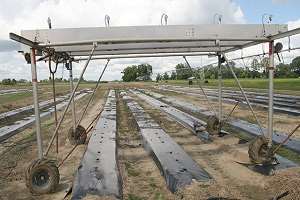By Kyle Dawson
A simulated rain research project coordinated by two University of Georgia scientists is aimed at enhancing and improving vegetable production.

A custom-built rainfall simulator previously developed by scientists at the U.S. Department of Agriculture (USDA) Southeast Watershed Research Laboratory in Tifton, Georgia, stands 10 feet wide, 10 feet long and about 10 feet high. By accurately simulating rainfall, the machine allows UGA researchers George Vellidis and Tim Coolong to study the effects that rain and runoff have on growing vegetables in plasticulture systems in Georgia.
The rainfall simulator has electrical hookups with power nozzles that spray water into troughs. Depending on the amount of rainfall desired, the simulator can dispense water through openings in the troughs to crops below. This allows the researchers to apply specific rainfall amounts to a cropping system in hopes of determining the percentage of rainfall that may be absorbed by plants under the plastic mulch, for example.
“Whether you want 1 inch of water per hour, a very light mist, or 6.5 inches an hour, it can be programmed to supply the water,” said Coolong, a horticultural scientist at the UGA Tifton Campus, who is collaborating with Vellidis, a precision agriculture specialist. “Consequently, you can look at runoff or rain splash events or water movement under plastic mulches.”
Coolong has wanted to study how much rainfall actually contributes to soil moisture under plastic mulches. This machine helps him collect real-world information that can be used to make irrigation recommendations to growers.
“When we try to manage irrigation, we don’t have a good handle on how much rain moves under the mulch and how much is runoff,” Coolong said.
Coolong is also teaming up with Vellidis and researchers from Emory University to study potential food safety risks due to soil splash using the rainfall simulator. They are looking at points of interest, such as rain splash of foodborne pathogens found in the soil that might affect the quality of fresh produce.
“As raindrops hit the soil, soil particles splash up onto plants,” Vellidis said. “We want to see if this rain splash can detach soil particles that carry bacteria and deposit them onto plants. If this happens, the bacteria could make humans sick if the edible portions of the plants are consumed raw.”
Vellidis applies nonpathogenic bacteria to the soil to see what rain events might transfer the bacteria from the soil to plants.
“In food safety, we’re concerned about certain types of E. coli and salmonella that are pathogenic,” Vellidis said. “We’re not actually going to use pathogenic bacteria in the study because we don’t want to spread them in the environment. Instead, we’re going to use nonpathogenic bacteria that will act as surrogates for the pathogenic bacteria.”
Coolong is also using the rain simulator to improve the Smart Irrigation application (http://smartirrigationapps.org) developed by the University of Florida. He wants to provide additional information to improve the app for vegetable growers by using the rain simulator to dial in rainfall amounts.
“If we can get this rainfall data incorporated into an appropriate model, we’ll be able to use that to make the app a little bit better,” Coolong said. “This app is basically tied into different weather stations, and it will tell you how much to irrigate based on temperature, sunlight and so forth. It doesn’t take into consideration, however, a lot of rain events when growing vegetable crops on plastic mulch. It would be nice to know how much the rainwater contributes to the overall irrigation of your crops on the plastic.”
Vegetable production is a huge industry in Georgia. It brought in a little over $1 billion in 2014, according to the most recent Georgia farm gate value report. Most of the top vegetable production occurs in the southern and southwestern parts of the state. Onions occupy the top spot in terms of the farm gate values for Georgia vegetables.
Source: uga.edu